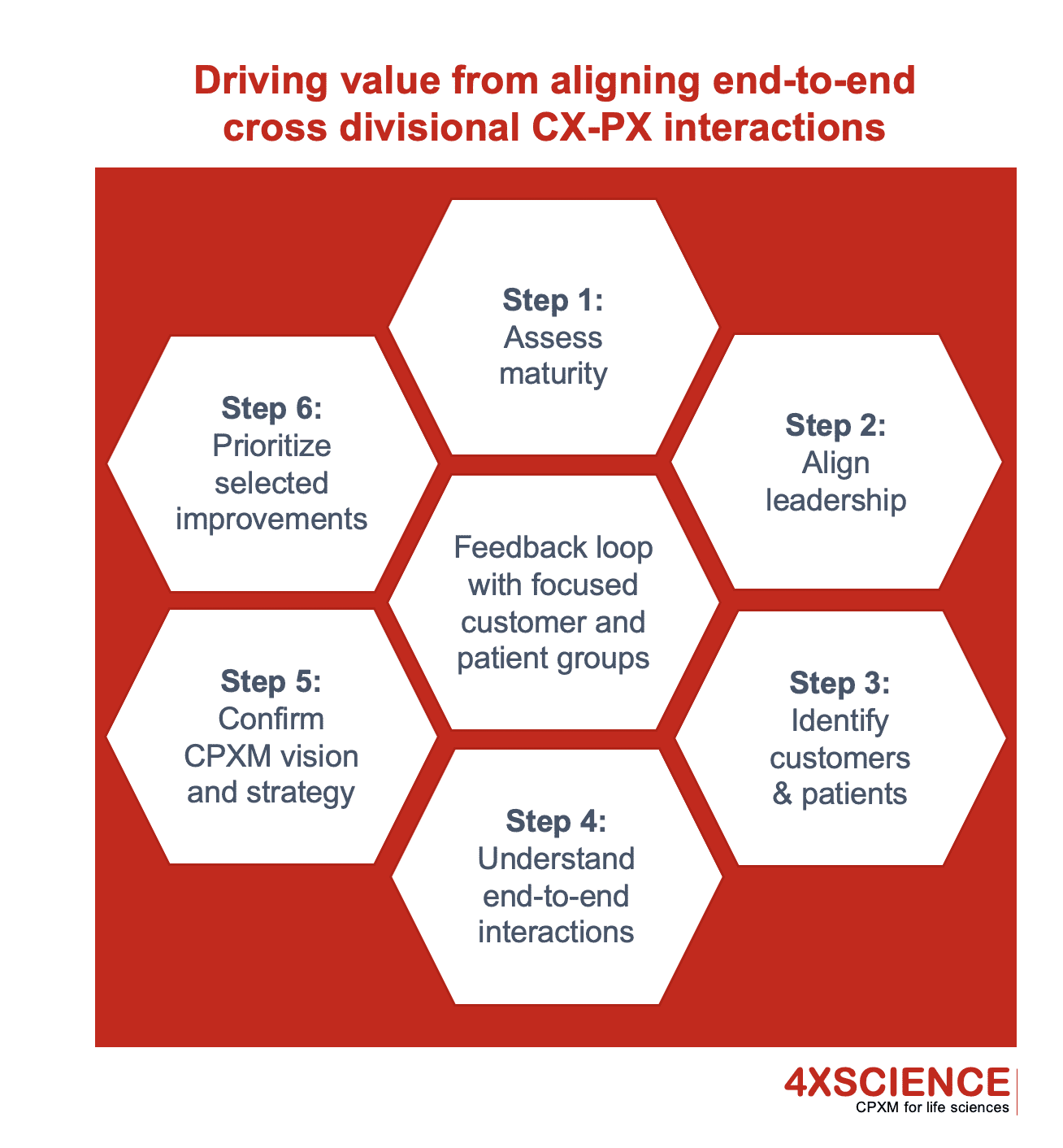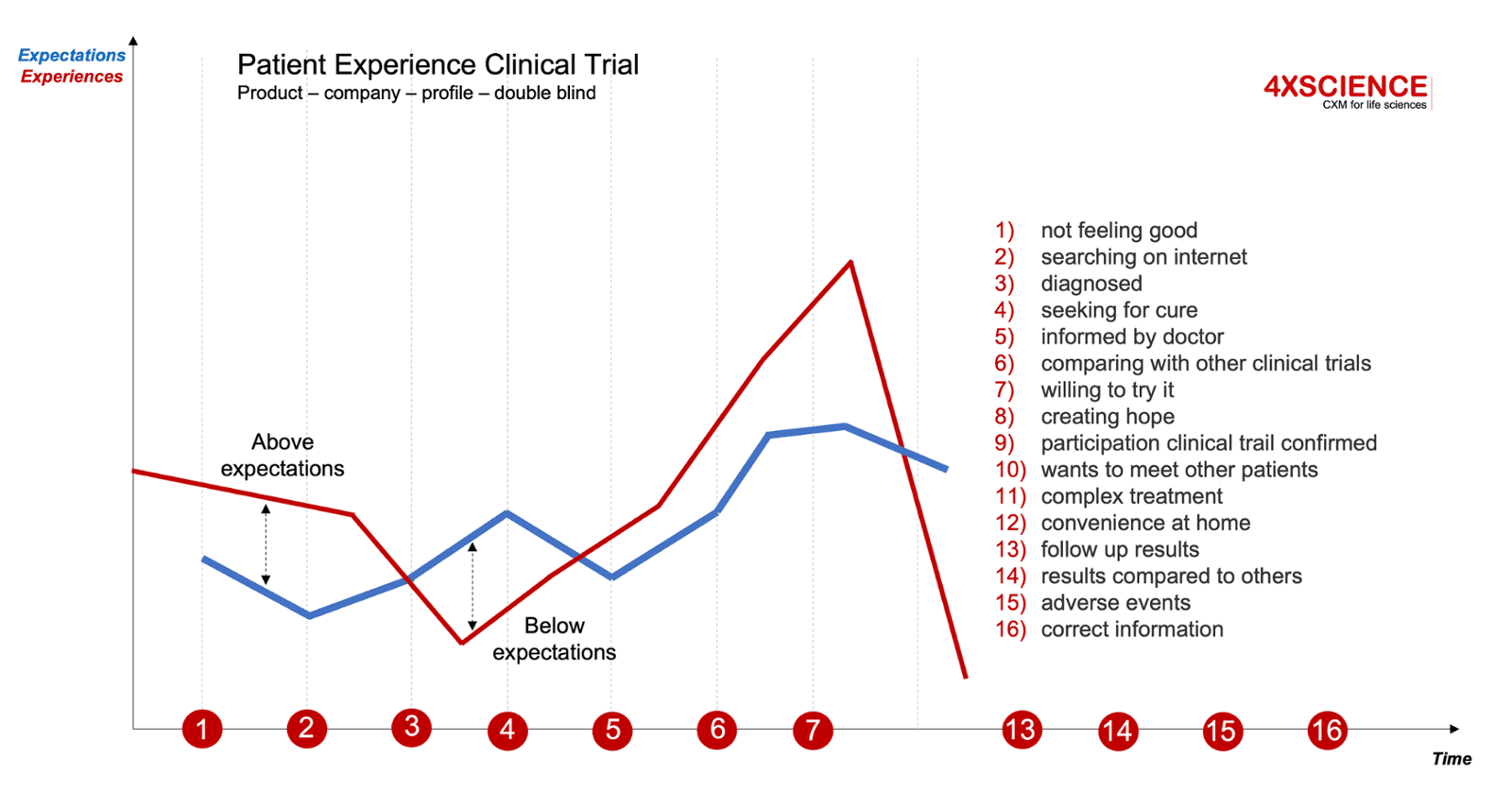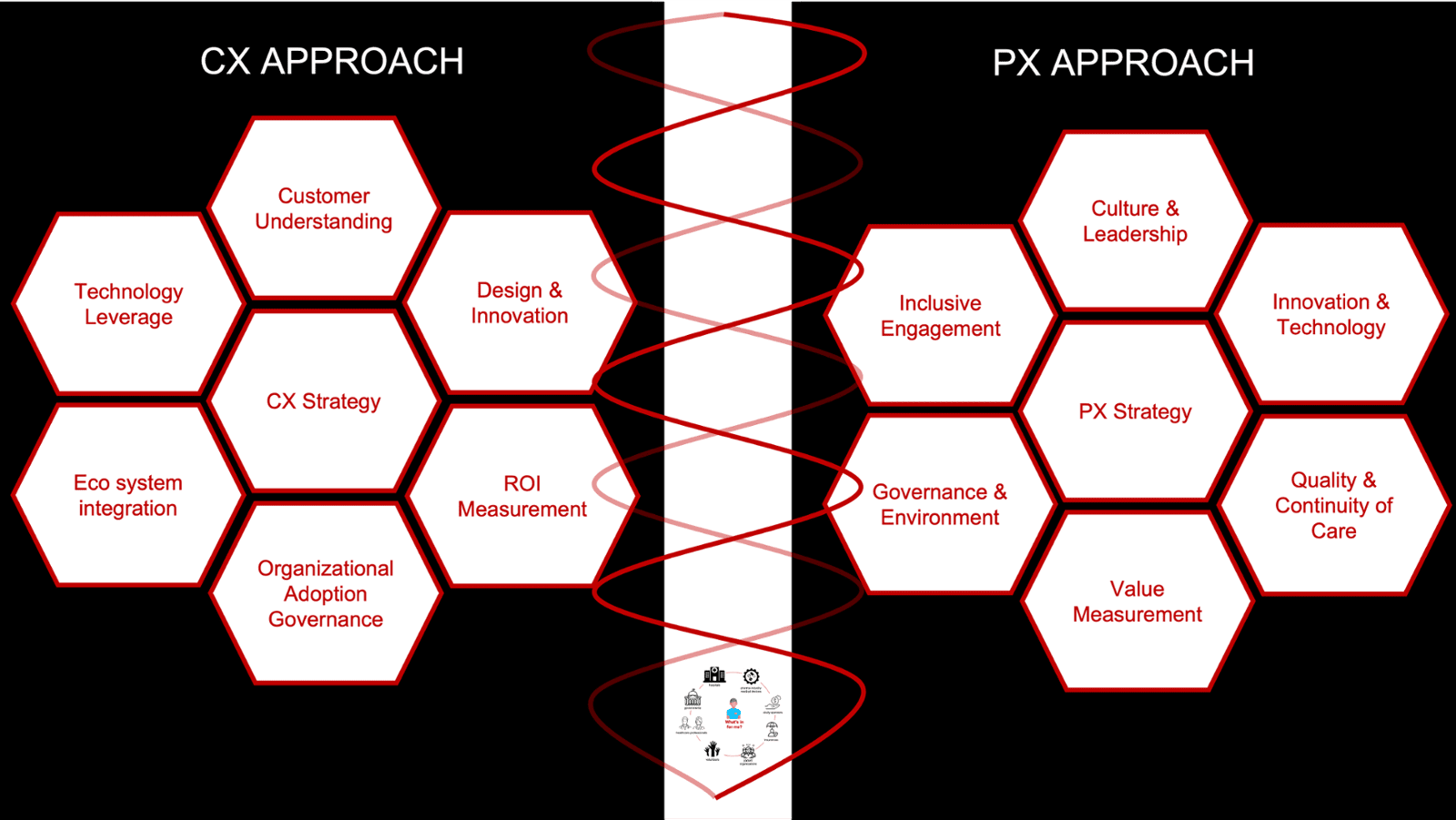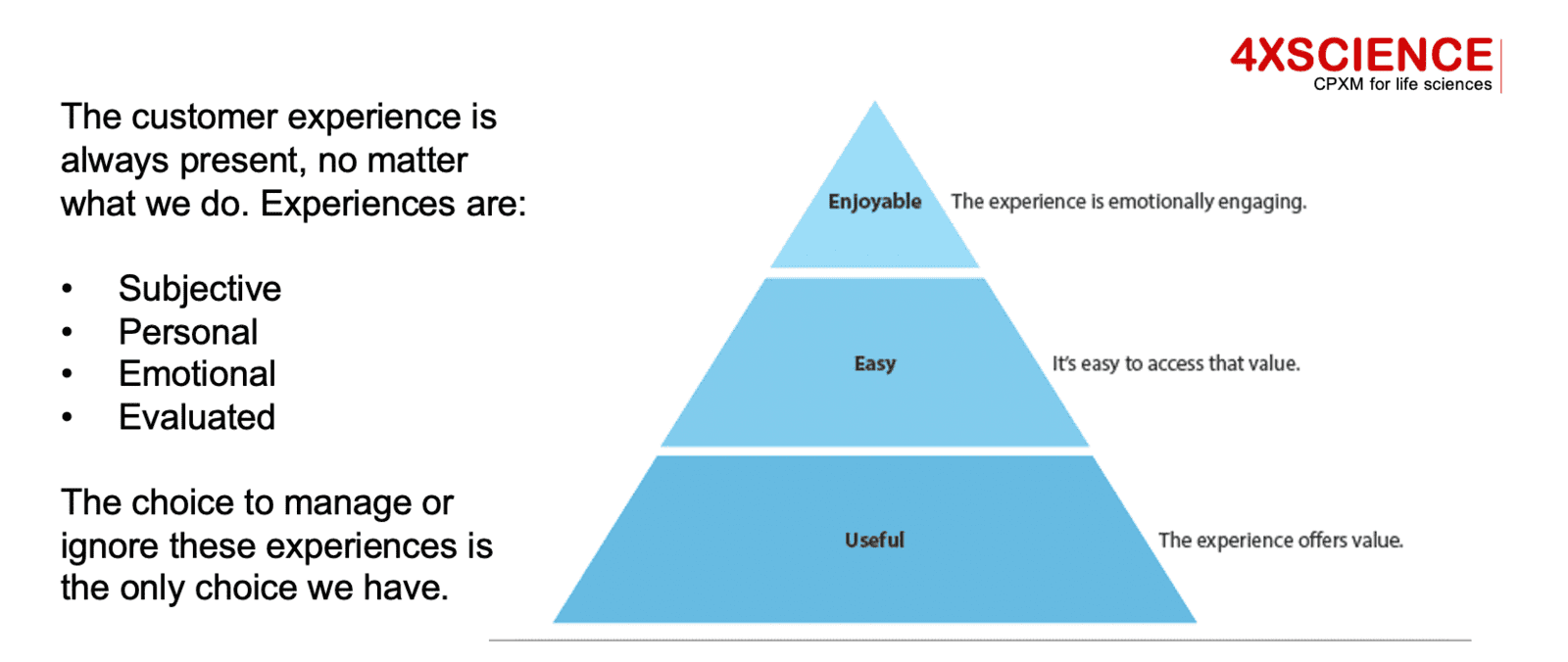Patient-oriented life science organizations aiming to improve customer and patient experiences, should develop consistent end-to-end CX-PX interactions across divisions from clinical into commercial. Due to differences and responsibilities, the alignment of these experiences proofs to be unexplored potential for value beyond the clinical outcome.

Our recent dealings with life science and healthcare organizations reveal how difficult it is to integrate and align divisions on the management of customer (CX) and patient experiences (PX) in one consistent approach. For big pharma, this refers to an approach beyond typical boundaries of R&D, Supply Chain, and Commercial (S&M). For hospitals, this refers to an approach across divisions and pathologies. Most organizations have distinctive leadership in each of these areas, each having its own set of metrics, objectives, and CX-PX understanding.
The effective implementation of consistent experiences usually require end-to-end business transformations that impact each of them. For example, improvements in customer experience triggered by commercial require transformations in supply chains to deliver. Changes to product packaging, product use, labelling, administration routes, require new development and regulatory activities impacting customers and patients. Likewise, directions for patient interactions during clinical development set a future baseline for commercial that might require deeper involvement from supply chain leaders as it impacts expectations. Improving patient experiences for hospitals require one consistent mindset across a large group of stakeholders with clear win-wins to sustain the efforts. Let alone, some of the trends such as RWE, PREMS, PED, GenAI that all drive on experience data collection.
In simple terms: nobody would think of supply chain transformations from inside the organization ignoring the outside view. Likewise, nobody can promise better CX or PX without commitments from supply chain or R&D to deliver on these promises. And yet, the integration and alignment of consistent experiences across these areas proofs to be an unexplored potential when organizations attempt to create additional value beyond the clinical outcome. Too often, each division is doing its own CX and PX as they each aim different objectives and don't necessarily want to spend time in other's areas beyond their responsibilities. Convincing leaders of an end-to-end cross-divisional approach for CX and PX, is hard to obtain.
Our acronym CPXM© highlights the need for this stronger end-to-end integration of CX and PX experiences from clinical to commercial:

CPXM© is a 4XSCIENCE acronym and refers to the need to manage customer and patient experiences in one single approach. CX and PX are entangled end-to-end, with alignment and integration being a key asset. Alignment between CX and PX concepts and across divisions.
How to overcome this lack of alignment and integration?
- Where do you stand today?
- How much support do you have?
- Who are your customers and patients?
- How to ensure the right focus?
- How to turn this into a strong win-win?
- Where to start the program?
- How to keep moving in the right direction?
The following 7 steps might get you started in the right direction and generate your list of CX-PX improvements across the organization:
Where do you stand today?
Step 1. Assess CX-PX maturity in each division
First, assess the status, maturity and integration of the current CX-PX models in each of the divisions on worldwide level, ideally across selective therapeutic areas, markets or pathologies. The assessment must be focused on both CX and PX and more specifically on the integration and alignment of both concepts in each division. How well is CPXM integrated and aligned today? This assessment must address all aspects - processes, people, technology and data - and include components such as strategy, customer understanding, ecosystem integration, design, innovation, inclusive engagement, continuity of care, culture, etc. Next, the recommendation is to compare your results with available benchmarks. Most companies will confirm the disconnect between CX and PX, will find a lack of integration from sales & marketing into supply chains, and will not see CX principles being deployed in most R&D areas. In contrast, they might find "patient" and "customer" oriented activities that mask real value for the patient and customer themselves: experience and AI terminology sounds good as long as they are done from a patient and customer perspective, beyond the own organizational needs only.
How much support do you have?
Step 2. Align with leadership
Using the assessment results, your next step is to align with leadership to ensure buy in at senior management level. These leaders need to see the potential in collaborating across their areas of responsibility with potentially less benefits for their division individually. With leaders having a preference for short term quick benefits, this step is difficult and might result in projects being cancelled or narrowed. Take your time and don't continue if leadership is not willing to handle this globally. As a minimum seek approval to move forward and return with numbers. Leaders do understand the "Patients First" mandate: work backwards from the very basic mission that sets patients and customers at the center, and call for more and closer engagements and connections to them. Value from small and easy wins generates data to bring them along in the process.

Who are your customers and patients?
Step 3. Identify customers and patients
With cross-divisional teams, identify and consolidate all customer and patient entities from clinical into commercial, from early development into product life cycle management. Start with a specific therapeutic area, product group, market, region and list down all key external entities for this scope that act as customer in your ecosystem to the patient. Repeat the same for your key segmented patient groups. CX and PX are both entangled end-to-end. Wins must be found in the interactions end-to-end for both customers and patients. Align on terminology and classify the importance of stakeholders from an end-to-end view. In this step, leaders will for example start to see that digital CX marketing or patient engagement are just fragmented steps in improving experiences. Likewise, changes to the product itself, repositioning of services, or transforming supply chain points have far more significant impact to CX and PX than assumed. In some organizations "heated" debates on customer definitions will arise ... who is actually our customer? A cross-divisional understanding of the key customer and patient groups gets everyone excited and aligned - sounds obvious, but usually it is not.
How to ensure the right focus?
Step 4. Understand end-to-end interactions (MoT)
For each of the identified customer and patient entities (wholesalers, hospitals, manufacturing partners, licensees, clinical sites, physicians, ...) we now want to understand and assess our end-to-end customer and patient interactions. When and how do we interact, and what are the expectations of this interaction? Some customers are present across all business segments, while others are only relevant for certain parts. A previous publication explained how expectations during clinical trials are to be offset against experiences, as improvements for patient experience result in benefits elsewhere in the value chain. Focus on the key Moments of Truth (MoT), selected by the teams and critical across divisions. Rate and quantify those interactions allowing you to define the right priorities.

How to turn this into a strong win-win?
Step 5. Confirm cross-divisional CPXM vision and strategy
Before selecting specific cases, the CPXM vision and strategy now needs to be (re-)confirmed across divisions. As part of this strategy, a win-win model needs to become the basis for ensuring success. Such a win-win model is extremely difficult as it must truly be assessed from a customer and patient point of view, while benefits for the company's divisions must be available (see step 6). What are the parameters that you will apply to assess, quantify and approve potential CX and PX improvements? What is the win-win direction against which potential improvements must be identified? To be translated in an articulated strategy for CX and PX.
Very often, teams tend to select initiatives that involve customers and/or patients while generating strong benefits for the company: that is not what will benefit patients in the long run (e.g. see previous article: e-consent is a red flag). This is not about involvement or engagement. True value must be found in easier, better, and cheaper products. Helping patients to get off the medication faster, is an example of improved patient experience. The challenge is to achieve this in a win-win model for all stakeholders. An aligned vision and strategy must set the boundaries on how to select real valuable PX and CX improvement projects while avoiding the plenty fakes. Smart, out-of-the-box thinking, creativity and innovation are key.
Where to start the program?
Step 6. Define, prioritize and select pragmatic improvements
Defining improvements that bring value beyond the clinical outcome of your product and service; improvements that are achievable in a reasonable timeframe, and bring measurable value to your business i.e. will generate a positive business inflow. This requires top experts across multiple domains and disciplines: engineers, economists, innovators, product development, regulatory, patient leaders, market analysts, who are able to think beyond the clinical outcome.
Focus is on improving the experience for customers and patients. Is our product and/or service convenient and easy to use? How can we create better experiences in a win-win model delivering value for customers and patients, and our organization? There is an entire science behind implementing this. In some interactions we want to excel, in others we simply do not. Similar as we explained for CX, we need to strategically select these moments of truth that matter for our patients and carefully balance expectations versus experiences. Improvements also need to be pragmatic: easy, quick wins, successful versus those requiring fundamental transformations across multiple business areas. Cross-divisional prioritization must be conducted using the win-win model so the value can be used as an objective tool to select the right priorities.
This step results in a list of multi year, multi divisional programs that are aligned with each other towards the same objective: Patients First.

How to keep moving in the right direction?
Step 7. Close the loop with focused groups
During previous steps, feedback loops with focused groups of customers and patients are maintained to ensure the team progresses well with close connection to stakeholders. This feedback is formalized before implementation of projects can start. Sessions are organized in an open discussion forum with selective and well-educated groups in products and therapeutics. The groups help to ensure customers and patients agree with the improvements in which will be invested. If you have done your work well, they will become your early adopters: patient and customer recruitment starts here. Feedback might result in a changed order of priority. Be aware "the customer doesn't always know what he or she wants", so evaluate carefully.
Organizations that succeed in the above, will be embedding CX and PX assessments in almost every investment consideration. The relevant questions are being raised when funds are requested. "This project, how much will it really benefit to our customers and patients? What will be the impact on the customer experience? Will it improve the patient experience? Do our key customers support this improvement? Will they benefit from the integrated services? Do they agree this will result in improved alignment?"
And that's where we need to be. For every investment, relevant CX and PX questions should be raised to ensure the work captures the outside-in views. Only in this way, life science organizations and hospitals can start to differentiate with experience management complementary to clinical outcomes, across divisions. They are embedding CX and PX in their culture.

No matter what organizations do, customer and patient experiences will always be present. Every single customer and every single patient will develop an opinion on your product and service. The choice to manage, integrate or ignore these experiences, is yours to make.
If this article was of any value, feel free to follow us for more details. 4XSCIENCE is a certified customer and patient practitioner (CCXP, CPXP) with 25 years of experience in life sciences. We support you in putting patients first.

